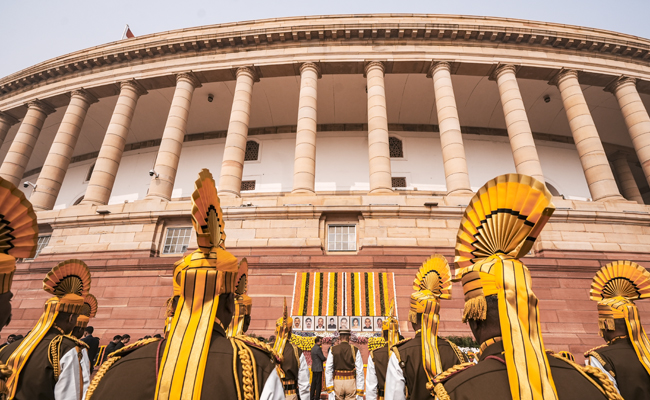Bengaluru (PTI): The Indian Space Research Organisation on Sunday successfully conducted the Reusable Launch Vehicle Autonomous Landing Mission (RLV LEX).
The test was conducted at the Aeronautical Test Range (ATR), Chitradurga, Karnataka, the national agency headquartered here said.
"With that, ISRO successfully achieved the autonomous landing of a space vehicle", it said in a statement.
"With LEX, the dream of an Indian Reusable Launch Vehicle arrives one step closer to reality", ISRO said.
In a first in the world, a winged body has been carried to an altitude of 4.5 km by a helicopter and released for carrying out an autonomous landing on a runway.
RLV is essentially a space plane with a low lift to drag ratio requiring an approach at high glide angles that necessitated a landing at high velocities of 350 kmph.
The RLV took off at 7:10 am IST by a Chinook Helicopter of the Indian Air Force (IAF) as an underslung load and flew to a height of 4.5 km (above Mean Sea Level).
Once the predetermined pillbox parameters were attained, based on the RLV's Mission Management Computer command, the RLV was released in mid-air, at a down range of 4.6 km.
Release conditions included 10 parameters covering position, velocity, altitude and body rates, etc. The release of RLV was autonomous. RLV then performed approach and landing maneuvers using the Integrated Navigation, Guidance & control system and completed an autonomous landing on the ATR air strip at 7:40 AM IST.
The autonomous landing was carried out under the exact conditions of a Space Re-entry vehicle's landing high speed, unmanned, precise landing from the same return path as if the vehicle arrives from space.
Landing parameters such as Ground relative velocity, the sink rate of Landing Gears, and precise body rates, as might be experienced by an orbital re-entry space vehicle in its return path, were achieved.
The RLV LEX demanded several state-of-the-art technologies including accurate Navigation hardware and software, Pseudolite system, Ka-band Radar Altimeter, NavIC receiver, indigenous Landing Gear, Aerofoil honey-comb fins and brake parachute system.
LEX utilised several indigenous systems. Localized Navigation systems based on pseudolite systems, instrumentation, and sensor systems, etc. were developed by ISRO.
Digital Elevation Model (DEM) of the landing site with a Ka-band Radar Altimeter provided accurate altitude information.
Extensive wind tunnel tests and CFD simulations enabled aerodynamic characterisation of RLV prior to the flight.
"Adaptation of contemporary technologies developed for RLV LEX turns other operational launch vehicles of ISRO more cost-effective", the statement said.
ISRO had demonstrated the re-entry of its winged vehicle RLV-TD in the HEX mission in May 2016. The re-entry of a hypersonic sub-orbital vehicle marked a major accomplishment in developing Reusable Launch Vehicles.
In HEX, the vehicle landed on a hypothetical runway over the Bay of Bengal. Precise landing on a runway was an aspect not included in the HEX mission.
The LEX mission achieved the final approach phase that coincided with the re-entry return flight path exhibiting an autonomous, high speed (350 kmph) landing.
The LEX began with an Integrated Navigation test in 2019 and followed multiple Engineering Model Trials and Captive Phase tests in subsequent years.
Along with ISRO, IAF, Centre for Military Airworthiness and Certification (CEMILAC), Aeronautical Development Establishment (ADE), and Aerial Delivery Research and Development Establishment (ADRDE) contributed to this test.
The IAF team hand in hand with the Project team and multiple sorties were conducted to perfect the achievement of release conditions.
Secretary in the Department of Space and ISRO Chairman S Somanath was among who witnessed the test.
India 🇮🇳 achieved it!
— ISRO (@isro) April 2, 2023
ISRO, joined by @DRDO_India @IAF_MCC, successfully conducted the Reusable Launch Vehicle Autonomous Landing Mission (RLV LEX)
at the Aeronautical Test Range (ATR), Chitradurga, Karnataka in the early hours on April 2, 2023.
Let the Truth be known. If you read VB and like VB, please be a VB Supporter and Help us deliver the Truth to one and all.
New Delh (PTI) The Congress on Saturday said it is perhaps not very surprising that India is not part of a US-led strategic initiative to build a secure silicon supply chain, given the "sharp downturn" in the Trump-Modi ties, and asserted that it would have been to "our advantage if we had been part of this group".
Congress general secretary in charge of communications Jairam Ramesh took a swipe at Prime Minister Narendra Modi, saying the news of India not being part of the group comes after the PM had enthusiastically posted on social media about a telephone call with his "once-upon-a-time good friend and a recipient of many hugs in Ahmedabad, Houston, and Washington DC".
In a lengthy post on X, Ramesh said, "According to some news reports, the US has excluded India from a nine-nation initiative it has launched to reduce Chinese control on high-tech supply chains. The agreement is called Pax Silica, clearly as a counter to Pax Sinica. The nations included (for the moment at least) are the US, Japan, the Republic of Korea, Singapore, the Netherlands, the United Kingdom, Israel, the United Arab Emirates, and Australia."
"Given the sharp downturn in the Trump-Modi ties since May 10th, 2025, it is perhaps not very surprising that India has not been included. Undoubtedly, it would have been to our advantage if we had been part of this group."
"This news comes a day after the PM had enthusiastically posted on his telephone call with his once-upon-a-time good friend and a recipient of many hugs in Ahmedabad, Houston, and Washington DC," the Congress leader asserted.
The new US-led strategic initiative, rooted in deep cooperation with trusted allies, has been launched to build a secure and innovation-driven silicon supply chain.
According to the US State Department, the initiative called 'Pax Silica' aims to reduce coercive dependencies, protect the materials and capabilities foundational to artificial intelligence (AI), and ensure aligned nations can develop and deploy transformative technologies at scale.
The initiative includes Japan, South Korea, Singapore, the Netherlands, the United Kingdom, Israel, the United Arab Emirates, and Australia. With the exception of India, all other QUAD countries -- Japan, Australia and the US -- are part of the new initiative.
New Delhi will host the India-AI Impact Summit 2026 on February 19-20, focusing on the principles of 'People, Planet, and Progress'. The summit, announced by Prime Minister Narendra Modi at the France AI Action Summit, will be the first-ever global AI summit hosted in the Global South.
Prime Minister Modi and US President Trump on Thursday discussed ways to sustain momentum in the bilateral economic partnership in a phone conversation amid signs of the two sides inching closer to firming up a much-awaited trade deal.
The phone call between the two leaders came on a day Indian and American negotiators concluded two-day talks on the proposed bilateral trade agreement that is expected to provide relief to India from the Trump administration's whopping 50 per cent tariffs on Indian goods.
In a social media post, Modi had described the conversation as "warm and engaging".
"We reviewed the progress in our bilateral relations and discussed regional and international developments. India and the US will continue to work together for global peace, stability and prosperity," Modi had said without making any reference to trade ties.





